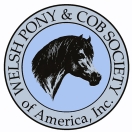


The Section D Welsh Cob exceeds 13:2 hands but may be either pony or horse size. As with the Section B and Section C Welsh, the Cobs developed from the Welsh Mountain Pony. In the 18th and 19th centuries, outcrosses to Norfolk Roadsters, Hackneys, Arabians and others resulted in the modern Cob. Cobs were employed as riding horses for the British Cavalry, transport for traveling doctors, farmers and other working people as well as delivery wagon animals in the cities. They have explosive trotting action and are unsurpassed in stamina and courage. Welsh cobs are in demand as both saddle and harness animals. Currently, they are becoming very competitive in the dressage world.
Breed Description: Exceeding 13:2 hands high with no upper limit General Character: Strong, hardy and active, with pony character and as much substance as possible. Color: Any color. Head: Full of quality and pony character. A coarse head and Roman nose are most objectionable. Eyes: Bold, prominent and set widely apart. Ears: Neat and well-set. Neck: Lengthy and well-carried. Moderately lean in the case of mares, but inclined to be cresty in the case of mature stallions. Shoulders: Strong but well laid back. Forelegs: Set square and not tied in at the elbows. Long, strong forearms. Knees well-developed with an abundance of bone below them. Pasterns of proportionate slope and length. Feet well shaped. Hooves dense. When in the rough, a moderate quantity of silky feather is not objected to but course, wiry hair is a definite objection. Middlepiece: Back and loins muscular, strong and well-coupled. Deep through the heart and well ribbed up. Hind Quarters: Lengthy and strong. Ragged or drooping quarters are objectionable. Tail well set on. Hind Legs: Second thighs, strong and muscular. Hocks large, flat and clean, with points prominent, turning neither inward nor outward. The hind legs must not be too bent and the hock not set behind a line falling from the point of the quarter to the fetlock joint. Pasterns of proportionate slope and length. Feet well-shaped, hooves dense. Action: Free, true and forcible. The knee should be bent and the whole foreleg should be extended straight from the shoulder and as far forward as possible in the trot. Hocks flexed under the body with straight and powerful leverage.


